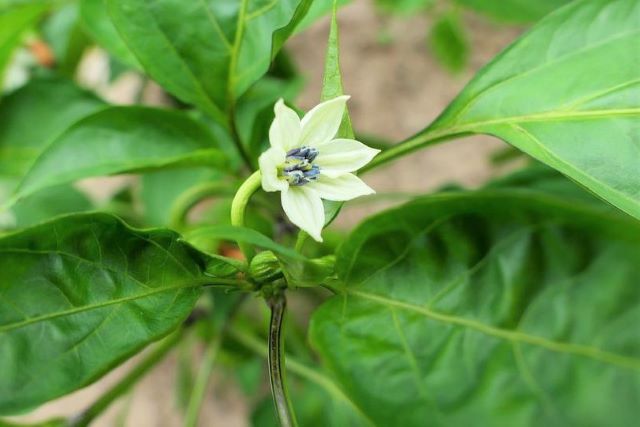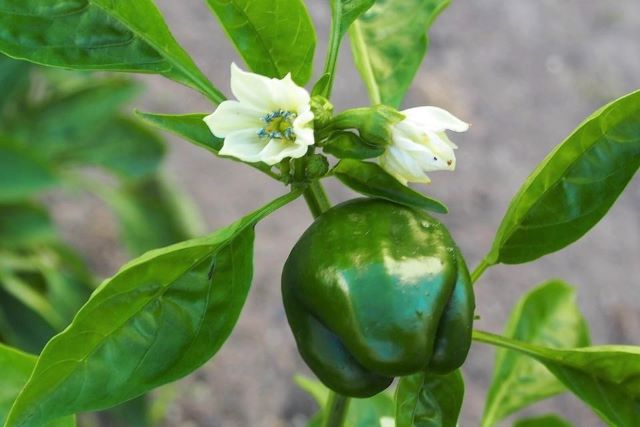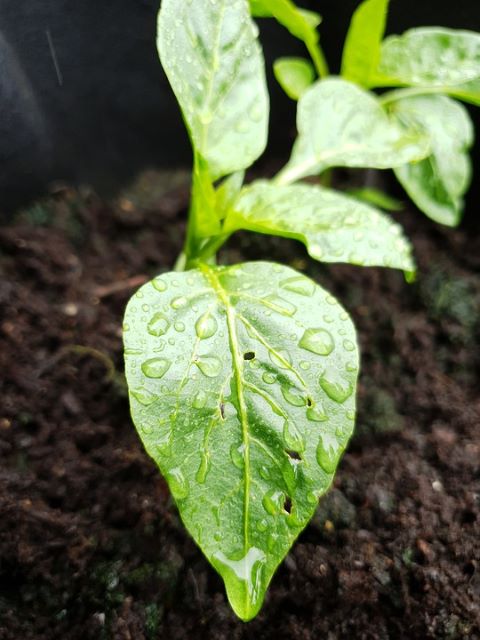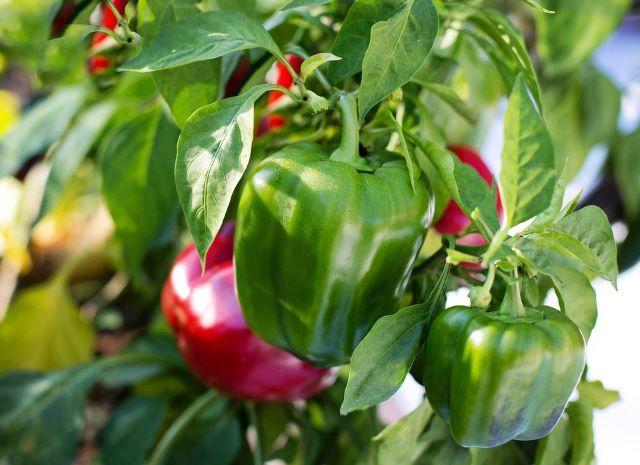Bell peppers are a popular ingredient to add to many dishes making them an exciting addition to the veggie garden. So if your bell pepper plant is flowering but not producing fruit, it can be frustrating. In this article, I’ll cover the possible reasons why your bell pepper plant is flowering but not fruiting, as well as how you can solve the problem for a delicious harvest this season.

The most common reasons for bell pepper plants flowering but not fruiting are a lack of pollination, incorrect growing temperatures, or poor soil conditions. A lack of sunlight and incorrect watering also play a role in bell pepper’s ability to produce fruit.
So firstly, don’t panic – your lack of peppers this year isn’t a reflection on your skills as a gardener. Gardeners of all experience levels can discover there are factors they’ve overlooked. Or that are broadly out of their control. Which then results in a disappointing bell pepper harvest.
Once we know what to look out for, we stand a better chance of creating the perfect environment for bell peppers to thrive. And a thriving bell pepper plant will produce fruit, giving you bell peppers bursting with color and flavor from the bud to the plate.
Related: Bell Pepper Pests and How to Get Rid of Them
Table of Contents
- Lack of Pollination Causes Bell Pepper Flowers But No Fruit
- Incorrect Growing Temperature Causes Bell Pepper Flowers But No Fruit
- Poor Soil Conditions Cause Bell Pepper Flowers But No Fruit
- Lack of Sunlight Affects Bell Pepper Growth
- Incorrect Watering Affects Bell Pepper Growth
- Provide the Best Growing Conditions for Bell Peppers
Lack of Pollination Causes Bell Pepper Flowers But No Fruit
Bell peppers are self-pollinating. This means the plant comes complete with male and female organs. In order for fruit to form, the female needs to receive pollen from the male.
Pollen is often spread by insects and the friendly bee is the most famous. But pollen can also be spread by the wind or by humans, as we shall soon see.
Unfortunately, with the widespread use of pesticides and monocultural farming, bee populations are decreasing around the world. This in turn means a decrease in healthy pollinating insects.
All plants that require pollination to seed and reproduce are affected by this and the bell pepper is no exception.
If you live in an area where lots of pesticides are being used, or where there are few bee-friendly flowers around, this may be a reason your bell pepper plant isn’t being pollinated properly.
Alternatively, if your bell pepper plants are poorly ventilated, this can lead to a lack of pollination as well.
I’ve heard some gardeners talking about how different plants grown in a house have fruited or not fruited depending on whether they’ve been left next to an open window or not.
Finally, the right level of humidity is required in order for the bell pepper flower pollen to be dispersed properly. Too much humidity and the male part of the bell pepper flower may struggle to release the pollen, which will become overly sticky.
And if humidity is too low and the air is overly dry, the female part may have difficulty holding onto the pollen once it is spread.
Solutions for Poor Pollination of Bell Pepper Flowers
Although you might feel disheartened at the prospect of trying to replenish entire bee populations, there are ways you can make your garden more bee-friendly. And every individual garden makes a difference.
Avoid using pesticides or chemical products that can harm insect life and try to plant plenty of bee-friendly flowers native to your area. This will help attract our black-and-yellow striped friends to the party.
Encourage your garden-loving neighbors to do the same!
Wildflower seed packs like this one are often a cheap and easy way of getting some insect-friendly color going in the yard.
For ventilation, try to ensure that any indoor bell pepper plants are kept near windows that are opened relatively frequently. If in a greenhouse, try to make sure there are vents, or that you keep the doors propped open every once in a while to allow a through draft.
How to Hand Pollinate Bell Pepper Plants
There are also ways of hand pollinating the bell pepper plants yourself. Once there are bell pepper flowers, try giving the plant a light shake or tap every few days. Not too hard though, or you’ll risk damaging the plant stems.
You can also use a Q-tip (cotton swab) to gently dab at each flowering bud in turn, helping to distribute the pollen around.
I’ve even heard of people using an electric toothbrush in order to imitate the buzzing movement of an actual bee. This is because the male part of the bell pepper plant will usually wait for vibrations before releasing its pollen!
If you need to adjust the humidity, try misting the area lightly using a spray water bottle. But be careful not to overdo it, as bell peppers tend to prefer remaining on the dry side. This is a workable solution if your bell peppers are in a greenhouse or small indoor space, less so if they are outside.
Incorrect Growing Temperature Causes Bell Pepper Flowers But No Fruit

Bell peppers can be a bit fussy when it comes to temperature. They’re not a particularly hardy plant.
A sharp frost or a sudden heat blast can prove enough to discourage them from fruiting and in some instances will even lead to the bell pepper plant dropping its blossoms prematurely.
As a general guide, bell peppers are comfortable with a daily temperature between 70-80 °F (21-27 °C).
For night temperatures bell peppers grow best between 60-70 °F (15-21 °C). For nights especially, this is really quite warm!
So although bell pepper plants might be able to cope with a few chilly spells, an extended period of cold, a heatwave, or a sharp frost can be enough to prevent fruit from forming.
Solutions for Incorrect Growing Temperature of Bell Peppers
Protecting bell peppers from temperature spikes is one reason people often opt to grow them in pots and containers. That way, bell peppers can then be moved indoors or out as the weather dictates.
If you’re looking to transplant your bell peppers plants from seedlings into the garden, make sure you wait until late enough in the spring so the risk of a late frost has passed.
Row covers like this one, can also be used to keep garden beds warm. They can also aid with protection against pests and other natural conditions. Such as harsh winds and heavy rain if your beds are exposed.
Finally, our taste for bell peppers even in cooler climates means that varieties have developed over the years better suited to chillier temperatures.
Although you’re not going to be harvesting peppers during an Alaskan winter any time soon, you can opt for shorter season varieties. That way you can take advantage of a shorter growing season and still grow gorgeous bell peppers. Consider Orange Bell, Orange King and King of the North.
Poor Soil Conditions Cause Bell Pepper Flowers But No Fruit
Bell peppers benefit from a soil pH balance of 6-6.8, so slightly acidic. Any higher or lower than this and the plant may struggle to soak up and utilize nutrients properly.
In terms of nutrients themselves, nitrogen is needed to help with green, leafy growth.
But once bell pepper plants reach the flowering stage, too much nitrogen can compromise flower and fruit production. This is due to the plant’s energy being poured into excess foliage.
If your bell pepper plant appears to be green and bushy, but with no fruit or flowers, this could be the cause.
Solutions to Fix Poor Soil Conditions for Bell Peppers
You can check the soil pH with a monitor like this one. If the pH levels are too high, try adding elemental sulfur to the soil, or you can add lime (calcium carbonate) if it’s too low.
To avoid a nitrogen overload, refrain from adding nitrogen-based fertilizer and focus on phosphorus and potassium during its flower and fruiting period. Although it’s worth remembering that some nitrogen is needed for healthy plant growth.
Aged animal manures and homemade compost are my preference. Both have a healthy balance of phosphorous and potassium as well as nitrogen. And by feeding the soil both prior to planting and throughout the growing season, you will be feeding your bell pepper plants.
In addition, an organic edible plant fertilizer like this one is particularly beneficial for bell pepper fruit formation and growth.
Lack of Sunlight Affects Bell Pepper Growth
No mystery here – peppers of all varieties need regular sunlight. Bell peppers grown in shade are far less likely to produce fruit!
No prizes for guessing the solution either. Make sure you’re planting bell peppers where they get at least 8 or more hours of sunlight a day.
If you find something is blocking bell peppers from getting adequate light, look for ways to increase the exposure. For example, you can look into trimming back tree branches or offending hedges. This will ensure your bell peppers are getting the sun they need.
You can also consider transplanting your bell pepper plant from a shady position into a more ideal growing space in the garden. Be sure to dig up the roots carefully to avoid damaging them.
Transplanting bell peppers can upset their growth but you can help establish them in their new spot with a feed of liquid seaweed fertilizer like this one.
Incorrect Watering Affects Bell Pepper Growth

Bell peppers require adequate watering for the health of the plant and fruit production.
Bell peppers won’t survive in desert-like conditions, but they don’t want to be swimming in water either. Soil that stays damp can lead to root rot. Which will, in turn, restrict the bell pepper plant’s ability to absorb the nutrients and moisture that it needs.
As a general rule, check the soil by hand to ensure it’s dry an inch below the surface before re-watering. Or you can use this soil monitor that among other things, checks the soil moisture level.
Keep an eye on the weather too. Bell peppers don’t need watering if rain is set to give them a good soaking.
Make sure you plant your bell pepper plants in well-draining soil. This is a good reason to opt for planting bell peppers in raised beds or containers. As they usually have better drainage.
Adding compost and aged manure to the soil prior to planting bell peppers will also improve soil draining.
Provide the Best Growing Conditions for Bell Peppers

Finally, make sure you’re practicing good garden husbandry to give your bell peppers the best possible environment for producing fruit.
Try to remove any burgeoning pests that appear on your bell pepper plant as soon as possible. Gentle removal with water and by hand will usually be sufficient to prevent early infestations from spiraling out of control.
Maintaining a healthy biosphere with plenty of natural predators is also important to keep pest populations in check.
Try to minimize weeds that will compete with your bell peppers for important nutrients. And keep the area in and around your beds tidy and well maintained.
The addition of mulch around your bell pepper plants will help with weed suppression. Mulch also retains soil moisture as well as feeds the soil as it breaks down over the season.
Bell peppers generally need 70-110 days of growing time. So be sure your growing season will allow for the bell pepper plant growth and fruit production.
You can get a head start on the bell pepper growing season by purchasing seedlings from a nursery. Or starting your bell pepper seeds indoors. You can read more on how to do that here: How to Start Vegetable Seedlings Under Grow Lights.
Further reading:
- Bell Peppers Not Germinating? 6 Tips to Sprout Them
- Brown Spots On Peppers: Causes And Solutions
- Why Are My Bell Peppers So Small? Answered!
- Why Are My Chilies Not Ripening? Causes And Solutions
- Growing Jalapenos: Planting and Harvesting Jalapeno Peppers
- Growing Tomatillo Plants and How to Eat Tomatillos
